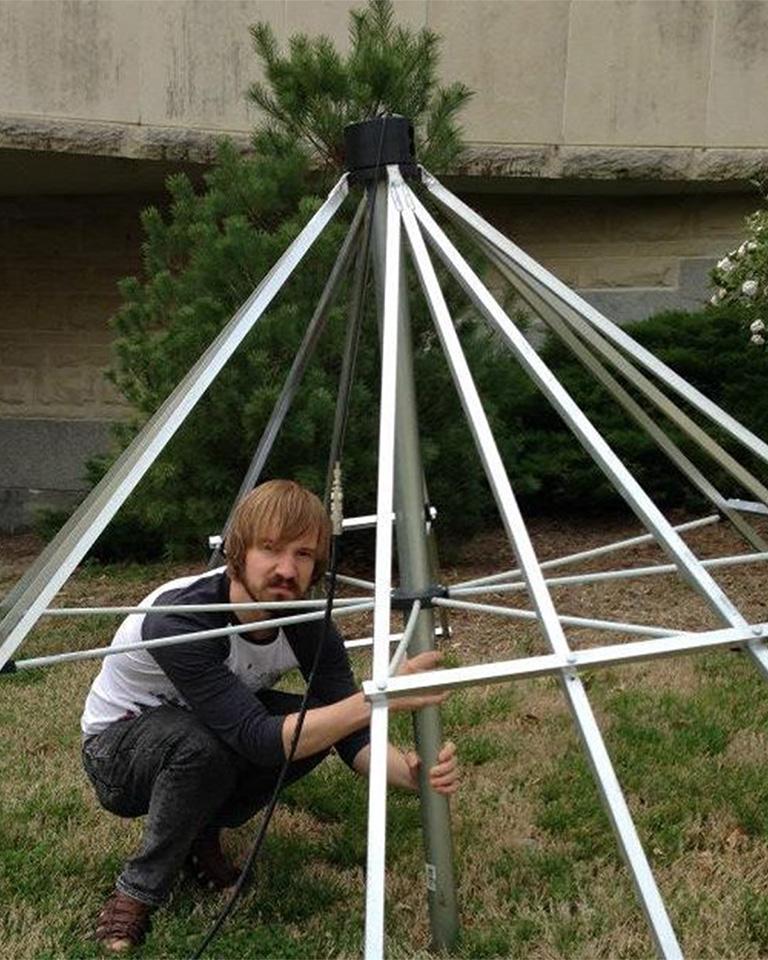Quincy Wofford

Summer 2022 Alumni Spotlight
KU Major: Interdisciplinary Computing - Physics
Graduation Year: 2017
Current Occupation: Scientist at Los Alamos National Laboratory
List the faculty member, staff, graduate student, or postdoc who mentored your research or creative project: Dave Besson
Describe the undergraduate research/creative experience that you had while at KU: When I was a second year undergraduate, Dave Besson set me to work on astroparticle physics experiments. Together with my research companion Kevin, we tried to bounce radio signals off the moon to calibrate a detection sensitivity threshold, which led to a couple UGRA awards. I used the UGRA travel award to present that work at a radio telescope conference in Albuquerque. Later, Kevin and I were sent to Wisconsin and Germany (respectively) to work on software related to the IceCube Neutrino Observatory at the South Pole. This time our funding came through the NSF, REU and IRES programs. Later, I was sponsored in my capacity as a student system administrator by Mike Hulet and the ITTC at KU to attend the SuperComputing (SC) conference. While attending SC, I met two scientists from Los Alamos National Laboratory. They became my mentors and helped me kick off my career after KU.
Questions:
Q: What did your research or creative project look like on a day-to-day basis? What did you spend most of your time doing?
A: For the moon bounce experiment, we wanted to send a radio signal from a source in Utah to the Moon, and then we wanted to use a detector in New Mexico to observe the signal bouncing off the Moon. We wanted to learn how that signal would change on the path to the moon and back. Kevin modified a tool to figure out when the path from Utah, to the Moon, and back to New Mexico would be possible. Then he worked with Dr Besson to make sure we could count on the signal to be transmitting...and when all that was in place, we'd interact with staff at the Long Wavelength Array (LWA) in New Mexico to time our observation. Once we had the data, Kevin and I would grab a table at Anschutz and spend time using frequency analysis tools in the Python programming language to determine if we saw anything suspicious...like a beam from Utah interacting with the Moon. We didn't succeed, but we learned about experiment design, linux and Python.
Q: What do you think was the most important thing you learned while doing undergraduate research?
A: It's important to choose great mentors. Look at a potential mentor's research and make sure they're doing something you're interested in. If you aren't doing this for fun, I imagine it could be hard to stay motivated. Regular classes can take a lot out of you! Having a research buddy helped too.
Q: What advice do you have for undergraduates who might be interested in doing research or creative scholarship?
A: Get involved early, and be a very good listener. Research can be technical and hard. You might not understand everything you're doing, but you need to understand your immediate objectives very well. As an undergraduate, that means listening very carefully and finding the difference between questions that would be good to know, and questions that are necessary to complete your work. Prioritize accordingly, because your mentor's time is valuable. There will be time for the "good to know" questions after you get some work done.
Q: Do you use any of the skills or perspectives gained doing research in your current occupation? How so?
A: I'm a scientist in the Applied Computer Science group at Los Alamos National Laboratory (LANL). I came to the lab after completing my IC-Physics degree in the EECS department at KU. I started at LANL as a post-baccalaureate intern, and then the lab sponsored my fellowship to attend grad school at the University of New Mexico where I earned a Master's degree in Computer Science. Both the technical and soft skills that were required for my undergraduate research were the reason I was able to make the connections that led me to Los Alamos. It's a fantastic place to work if you like physics and lifelong learning. Currently I work with supercomputers and physics teams to build portable software environments for physics simulations. I spend most of my time talking to people, writing scripts, and designing automation systems. The computer science-y explanation is that I build high performance kernel interfaces for distributed applications and guide the development of continuous integration and deployment systems for HPC.
Q: Many undergraduate researchers are making decisions about what to do after they graduate from KU. Having been in those shoes, what do you know now that you wish you’d known then? Do you have any advice?
A: I'm biased by the lifelong learning bug...but... Attend conferences as a student volunteer, ask good questions, and get comfortable moving through a room with some social awkwardness in the air. The ability to discuss and network is highly valued in the spaces I've worked in. Get comfortable not knowing and don't be embarrassed for not knowing. It never gets better, the topics get broader as your knowledge gets deeper and you'll always be ignorant around the edges. Mysteries can inspire you and they can bother you, and sometimes they do both. Don't let that self-doubting imposter syndrome stuff creep in. Always have a job or a project that you are excited to talk about during an interview. Having a narrative goes a long way toward getting the job. Passionate people are excited about their work, and they like to see that in candidates.